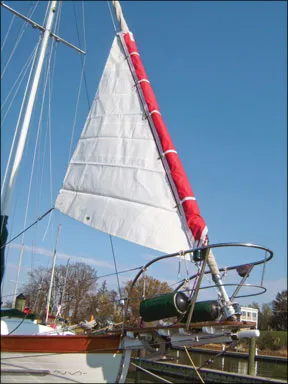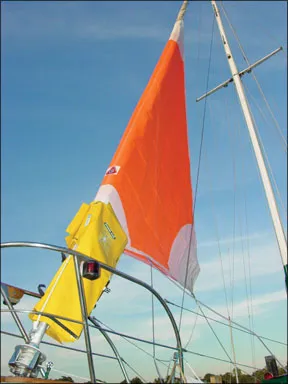The advent of roller furling and its rise to “must have” sailing gear status over the last few decades has inadvertently generated a new area of concern, one that our hank-on headsail seafaring forefathers would find almost laughable: the inability to bend on a storm jib when the need arises. Unless your boat is cutter rigged, or rigged with a solent stay or inner forestay to accommodate heavy-weather headsails (including a storm jib), the usual option in heavy weather is a deeply furled genoa. While roller furling eases the burden of the modern sailor most of the time, it is a weak ally in strong winds, particularly when trying to sail above a broad

288
reach. When the wind pipes up, you want a dedicated headsail that holds its shape, places the center of effort where you need it, and minimizes heeling forces.
Practical Sailor
Both the Gale Sail and Storm-Bag address the roller furling-storm jib issue, but they do it with distinctly different designs. Our evaluation compared not only basics (cost and quality of construction), but also ease of use and other pros and cons associated with each design. For additional comments from a sailmaker’s perspective, we turned to David W. Baxter, owner of Baxter Sailmakers (www.
baxtersailmakers.com), a well-respected loft in Norfolk, Va. We did not get the chance to deploy these sails in heavy weather, but if given the opportunity, we hope to this sailing season.
Before we delve into these products though, a quick summary of Practical Sailor’s two preferred storm jib options is in order. These alternatives are compared to the reviewed products in a table on the facing page.
• Storm jib on a staysail stay: This sail sets on an inner forestay that runs parallel to the headstay, usually attaching at the top spreader and well aft of the headstay. It can be removable and almost always requires running backstays to support the mast. Retrofitting can be expensive and require significant deck reinforcement.
• Storm jib on solent stay: This sail sets on a stay that leads from the masthead (or near it) to a fitting aft of the headstay. Because it does not require running backstays, it can be cheaper than adding an inner forestay, but it still requires significant modification. The slot is usually too small for the stay to remain in place during tacking maneuvers. Some boats can make use of extra halyard fittings and hardware to accommodate a removable solent stay, further reducing costs.
Ideally, either of these arrangements should be carried out with input from the boat’s designer and/or manufacturer, a qualified rigger, and a sailmaker, who will be able to provide valuable information on gear selection and installation details. This is a project where cutting corners can have serious consequences.
In the view of Practical Sailor, either one of these retrofits is a much better option than the products reviewed here.
The Gale Sail
ATN’s Gale Sail has been available for well over a decade, and we first recommended it in July 1997, saying it would be “well used in tradewind conditions,” but we remained unconvinced it eliminates the need for a conventional storm jib and inner forestay. Construction for the sail we tested this time, 60 square feet of 8-ounce Dacron, was good and included features such as oversized piston hanks, webbed grommets, and a high-visibility luff pouch. The sail was initially offered in orange, but it is currently only available in white with a red sleeve.

288
The Gale Sail comes packed in a traditional sail bag. To deploy, the user wraps the genoa sheets around the furled genoa, down to the deck, and secures them. Next, the tack is secured, and the Gale Sail is hanked on over the furled genoa, forming a sleeve. The sheets are then attached, and the sail is hoisted using a spare jib or spinnaker halyard.
Users will want to practice hoisting the Gale Sail in calm conditions to get familiar with the setup and find the best way to route the sheets. Since the roller-furling sail’s sheets will be used to secure the genoa, the Gale Sail will require dedicated sheets.
For either sail, you will probably have to unreave the genoa sheets from the lead cars to accommodate the storm jib’s sheets. Another option would be to have double-sheave cars or install a second set of cars well forward on the track.
Hanking the Gale Sail on to the jib is simple as both the pistons and their matching grommets are clearly labeled. However, testers found working the piston hanks into position to be tough, due primarily to the stiffness of the new sail and restricted articulation of the hanks. Because the crew will be working with a flogging sail at the bow of the boat, exposed to wind and waves, this sail is best set before conditions get too rough.
The Gale Sail hoists easily in calm weather, but we see a number of problems that could arise while hoisting in an actual storm. One possible problem noted by our testers is that the sleeve could be a tight fit in some cases, such as on a more loosely furled jib or a stiff sail that may not roll up as tightly. On the other hand, once the sleeve is in place, it helps prevent accidental unfurling of the genoa. (Sailors who already own a storm jib can have their sail retrofitted to fit over their furled genoa by ATN for $22 per foot of luff length.)
ATN maintains that as the Gale Sail is hoisted over the stiff roller-furled sail and foils, it maintains a good aerodynamic shape, one that is better than that of a conventional storm jib hanked on to a removable headstay. While the Gale Sail sets better than a partially furled jib, a well-designed storm jib and stay arrangement will offer better performance, in our view.
Dousing, removing, and stowing the Gale Sail is straightforward, similar to a conventional storm jib.
Bottom line: The Gale Sail is well-made and for a sailor looking for this type of product, it is a better option than the Storm-Bag. At $740, the 60-square-foot sail recommended for our 36-foot full-keeled test boat (a Union 36) is approximately $350 less than a comparably sized Storm-Bag, although the Storm-Bag comes with sheets.
THE STORM-BAG
Available from New Jersey-based Banner Bay Marine, the Storm-Bag is a “double-sided” storm jib compactly stowed in a custom bag that fits around a furled jib like a saddle. The sail (offered in international orange) is deployed directly from the bag; simply snap the provided tack line to the roller-furler drum (or suitable deck strong point), attach a halyard, then snap on the included sheets, and route them to the cockpit.
The sail remains secure in its bag until hoisted, a feature our testers liked. This meant no wrestling with the sail during preparation for deployment. Once back in the cockpit, the user pulls on the leeward sheet to release the sail from its bag, and then hauls up the halyard to raise the sail.
Testers found construction of the Storm-Bag to be good. The model tested (#SB06, for boats 27 to 35 feet) is 65 square feet and constructed of double layers of 6-ounce Dacron sailcloth.
The Storm-Bag is advertised as having many advantages over a conventional storm jib: compact stowage, easier deployment, and reduced likelihood of the genoa unfurling in high winds (although not to the degree provided by the Gale Sail sleeve arrangement). The stowed sail is compact, but the other stated advantages are offset by potential problems, in our opinion.
Because it folds loosely over the furled genoa, the Storm-Bag will easily fit, no matter how bulky the genoa is. The maker says it can also be deployed over a forestay foil, but only as a temporary get-me-home solution.
A downside to this “fold-over” design is that you’re dealing with twice as much sailcloth as you really need. This could make it more difficult to manage in a storm, since you’ll have potentially 130 square feet of material flogging around. The Storm-Bag is easy to deploy heading into the wind, but it could be a handful should the wind whip between the fold and start the two halves flogging.
While the quality of construction was good, our testers raised several issues with the Storm-Bag. For one, PS is not a big fan of utilizing snap shackles on a heavy-weather sail, and the storm bag uses one to attach the sheets. Crew members will want to stay well clear of this shackle when hoisting or dousing.
Testers also didn’t like the thin, 1-inch-wide Velcro used to close the ends of the launching bag. (The maker has tried a wider strip, but it caused the bag to tear.) Also, once the sail is deployed, the bag remains attached at the bottom, and would likely be flapping in the wind.
Another issue is that the Storm-Bag is hard to properly repack after use. It seems that the best way to repack the sail is to stuff it into a sail bag, take it ashore at the next landfall, and origami-fold it back into the storage bag.
Bottom line: At $1,100, the 65-square-foot sail presents too many potential issues, in our opinion, to recommend it for heavy-weather use. The maker is looking at improving some of the design elements.
Conclusion
If a storm jib for offshore sailing is what you want, neither of these products is an ideal option, in our opinion. The Gale Sail is better than nothing in conditions where a furled genoa may fall short—deep reaching or running in reinforced trades, or heaving to in reinforced trades are two examples that come to mind—but neither merits the name “storm sail” in our opinion. An offshore sailor’s money is better spent in developing a proper storm jib setup, one that employs either an inner forestay or a solent stay and allows for a hank-on heavy-weather jib, and for severe conditions, a dedicated storm jib. With luck, you’ll never find yourself in a situation that requires such a sail, but if you do, you will want one that is up to the task.
recently evaluated two products that claim to restore the missing storm jib capability on vessels with roller-furling headsails, the ATN Gale Sail and the Storm-Bag from Banner Bay Marine. Each is advertised as an ideal solution for roller-furling equipped vessels lacking an inner forestay, allowing sailors to hoist a storm jib without the need to remove the genoa.

































